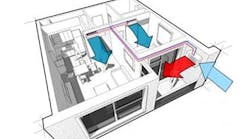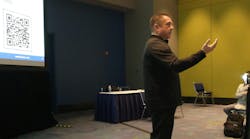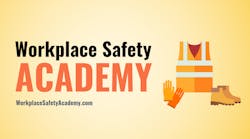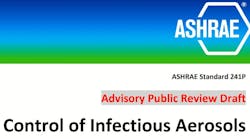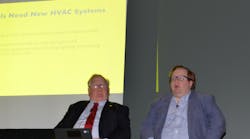by Kevin V. O’Neill
During a recent chat with another contractor, I mentioned that a large part of what I was doing in my new company was mold- and humidity-related. He told me that his liability insurance carrier informed him that if he did any mold work, they would drop him. Therefore, he says he’s staying away from mold work and suggested that I do the same. We then got into a lively discussion on mold problems and whether or not anything could be done about them.
Shortly after that conversation, I received my homeowner’s insurance renewal declarations. I noticed that for the first time that mold repairs of more than $5,000 were excluded from my policy. A week later, an article in the newspaper stated that many insurance carriers were dropping or reducing mold coverage in their homeowners policies.
With all the attention mold is receiving lately, I would like to take a moment and point out that if you’re an HVAC contractor, you ARE in the mold business. If any of your past or present customers have a mold problem, you’re already involved. If the insurance companies won’t pay to fix it, then their lawyers will expect YOU to pay to fix the problem.
The question here is whether you pay to fix the problem or get paid to fix the problem. I prefer the latter.
What Are Our Options?
Five conditions are required for mold growth:
- Air. We can’t eliminate air from our environment, so air removal can’t be used to control mold.
- Food. Mold can use almost anything as a food source. Drywall, dirt, our food, etc., are all potential foods for mold.
- Heat. Temperatures between 40F and 120F are sufficient for mold growth. However, controlling the temperature so that it is outside that range would make life impossible for people, too.
- Mold spores. Better filtration and UV lights can reduce the number of mold spores in the air, but we can’t eliminate them, except possibly in a clean room. Since no one lives in a clean room, that’s not a viable mold control option, either.
- Moisture. Now we’re on to something. There must be liquid water or relative humidity (RH) above 80% at the surface for mold to survive. For some molds, RH must be above 90%.
The only thing that we can change that will make life impossible for mold, without also making life impossible for people, is to lower the relative humidity in our conditioned spaces. This is part of what air conditioning is supposed to accomplish. In the past, all we controlled was temperature, with humidity as a side effect. That has to change.
Humidity control will be even more of a problem when the new, government-mandated higher efficiencies take effect in a couple of years. High-efficiency equipment doesn’t always dehumidify as well as less efficient equipment. This is because the indoor coils on high-efficiency equipment have more surface area than older coils. Although they deliver the same amount of heat transfer, high-efficiency coils often don’t get as cold as the older coils.
Take a Look in the Mirror
Do you do a load calculation on every job? Do you pay attention to the sensible/latent split when making equipment selections? Do you install variable speed blowers on every job? Do you seal the ducts on every installation and change-out? Do you set the airflow to the correct amount on every job? Do you install a dehumidistat? If you don’t do these things and more, you’re asking for trouble — for both your customers and yourself.
If you don’t have them yet, you should buy an air flow hood, blower door, wood moisture meter, duct blaster, sling psychrometer, psychrometric chart, and other air measuring test equipment, and learn how to use them. If you can’t properly measure the conditions of the air, how can you possibly work in air conditioning?
This is a brave new world we’re entering. If you don’t want to learn the skills needed to address mold problems, then you should either get out of this business or get on a first name basis with a good lawyer. For the rest of us brave souls, now is the time to stop selling boxes and start providing solutions for our customers. It’s time to put the AIR back into air conditioning. n
Kevin V. O’Neill is the owner of O’Neill Cooling & Heating, Myrtle Beach, SC. He has 26 years of experience in the HVAC service business. Kevin can be reached at 843/385-2220.
